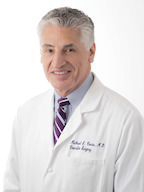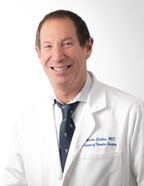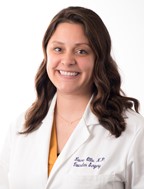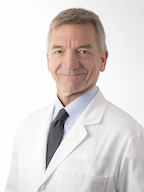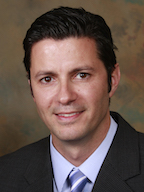Atherosclerosis
Atherosclerosis is a disease in which plaque builds up inside your arteries. Arteries are blood vessels that carry oxygen-rich blood to your heart and other parts of your body.
Plaque is made up of fat, cholesterol, calcium, and other substances found in the blood. Over time, plaque hardens and narrows your arteries. This limits the flow of oxygen-rich blood to your organs and other parts of your body.
Atherosclerosis can lead to serious problems, including heart attack, stroke, or even death.
Atherosclerosis
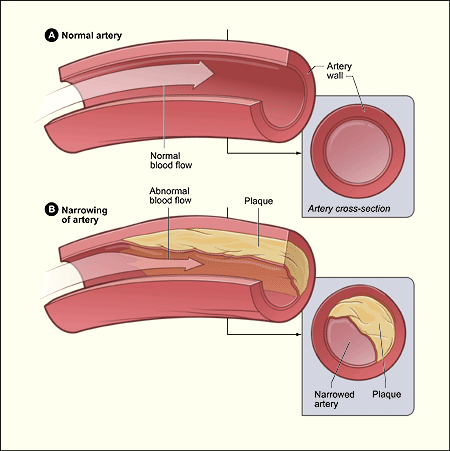
Figure A shows a normal artery with normal blood flow. The inset image shows a cross-section of a normal artery. Figure B shows an artery with plaque buildup. The inset image shows a cross-section of an artery with plaque buildup.
Atherosclerosis-Related Diseases
Atherosclerosis can affect any artery in the body, including arteries in the heart, brain, arms, legs, pelvis, and kidneys. As a result, different diseases may develop based on which arteries are affected.
Coronary Heart Disease
Coronary heart disease (CHD), also called coronary artery disease, occurs when plaque builds up in the coronary arteries. These arteries supply oxygen-rich blood to your heart.
Plaque narrows the coronary arteries and reduces blood flow to your heart muscle. Plaque buildup also makes it more likely that blood clots will form in your arteries. Blood clots can partially or completely block blood flow.
If blood flow to your heart muscle is reduced or blocked, you may have angina (chest pain or discomfort) or a heart attack.
Plaque also can form in the heart's smallest arteries. This disease is called coronary microvascular disease (MVD). In coronary MVD, plaque doesn't cause blockages in the arteries as it does in CHD.
Carotid Artery Disease
Carotid (ka-ROT-id) artery disease occurs if plaque builds up in the arteries on each side of your neck (the carotid arteries). These arteries supply oxygen-rich blood to your brain. If blood flow to your brain is reduced or blocked, you may have a stroke.
Peripheral Artery Disease
Peripheral artery disease (P.A.D.) occurs if plaque builds up in the major arteries that supply oxygen-rich blood to your legs, arms, and pelvis.
If blood flow to these parts of your body is reduced or blocked, you may have numbness, pain, and, sometimes, dangerous infections.
Chronic Kidney Disease
Chronic kidney disease can occur if plaque builds up in the renal arteries. These arteries supply oxygen-rich blood to your kidneys.
Over time, chronic kidney disease causes a slow loss of kidney function. The main function of the kidneys is to remove waste and extra water from the body.
Overview
The cause of atherosclerosis isn't known. However, certain traits, conditions, or habits may raise your risk for the disease. These conditions are known as risk factors.
You can control some risk factors, such as lack of physical activity, smoking, and an unhealthy diet. Others you can't control, such as age and a family history of heart disease.
Some people who have atherosclerosis have no signs or symptoms. They may not be diagnosed until after a heart attack or stroke.
The main treatment for atherosclerosis is lifestyle changes. You also may need medicines and medical procedures. These treatments, along with ongoing medical care, can help you live a healthier life.
Outlook
Improved treatments have reduced the number of deaths from atherosclerosis-related diseases. These treatments also have improved the quality of life for people who have these diseases. However, atherosclerosis remains a common health problem.
You may be able to prevent or delay atherosclerosis and the diseases it can cause. Making lifestyle changes and getting ongoing care can help you avoid the problems of atherosclerosis and live a long, healthy life.
Describes how the build-up of plaque over time causes atherosclerosis which can lead to serious problems, including heart attack, stroke, or even death. Shows how in atherosclerosis, plaque builds up inside the arteries which can cause a heart attack. Explains that the main treatment for atherosclerosis is lifestyle changes, such as following a healthy diet, quitting smoking, and being physically active.
Other Names for Atherosclerosis
- Arteriosclerosis
- Hardening of the arteries
What Causes Atherosclerosis?
The exact cause of atherosclerosis isn't known. However, studies show that atherosclerosis is a slow, complex disease that may start in childhood. It develops faster as you age.
Atherosclerosis may start when certain factors damage the inner layers of the arteries. These factors include:
- Smoking
- High amounts of certain fats and cholesterol in the blood
- High blood pressure
- High amounts of sugar in the blood due to insulin resistance or diabetes
Plaque may begin to build up where the arteries are damaged. Over time, plaque hardens and narrows the arteries. Eventually, an area of plaque can rupture (break open).
When this happens, blood cell fragments called platelets (PLATE-lets) stick to the site of the injury. They may clump together to form blood clots. Clots narrow the arteries even more, limiting the flow of oxygen-rich blood to your body.
Depending on which arteries are affected, blood clots can worsen angina (chest pain) or cause a heart attack or stroke.
Researchers continue to look for the causes of atherosclerosis. They hope to find answers to questions such as:
- Why and how do the arteries become damaged?
- How does plaque develop and change over time?
- Why does plaque rupture and lead to blood clots?
Who Is at Risk for Atherosclerosis?
The exact cause of atherosclerosis isn't known. However, certain traits, conditions, or habits may raise your risk for the disease. These conditions are known as risk factors. The more risk factors you have, the more likely it is that you'll develop atherosclerosis.
You can control most risk factors and help prevent or delay atherosclerosis. Other risk factors can't be controlled.
Major Risk Factors
- Unhealthy blood cholesterol levels. This includes high LDL cholesterol (sometimes called "bad" cholesterol) and low HDL cholesterol (sometimes called "good" cholesterol).
- High blood pressure. Blood pressure is considered high if it stays at or above 140/90 mmHg over time. If you have diabetes or chronic kidney disease, high blood pressure is defined as 130/80 mmHg or higher. (The mmHg is millimeters of mercury—the units used to measure blood pressure.)
- Smoking. Smoking can damage and tighten blood vessels, raise cholesterol levels, and raise blood pressure. Smoking also doesn't allow enough oxygen to reach the body's tissues.
- Insulin resistance. This condition occurs if the body can't use its insulin properly. Insulin is a hormone that helps move blood sugar into cells where it's used as an energy source. Insulin resistance may lead to diabetes.
- Diabetes. With this disease, the body's blood sugar level is too high because the body doesn't make enough insulin or doesn't use its insulin properly.
- Overweight or obesity. The terms "overweight" and "obesity" refer to body weight that's greater than what is considered healthy for a certain height.
- Lack of physical activity. A lack of physical activity can worsen other risk factors for atherosclerosis, such as unhealthy blood cholesterol levels, high blood pressure, diabetes, and overweight and obesity.
- Unhealthy diet. An unhealthy diet can raise your risk for atherosclerosis. Foods that are high in saturated and trans fats, cholesterol, sodium (salt), and sugar can worsen other atherosclerosis risk factors.
- Older age. As you get older, your risk for atherosclerosis increases. Genetic or lifestyle factors cause plaque to build up in your arteries as you age. By the time you're middle-aged or older, enough plaque has built up to cause signs or symptoms. In men, the risk increases after age 45. In women, the risk increases after age 55.
- Family history of early heart disease. Your risk for atherosclerosis increases if your father or a brother was diagnosed with heart disease before 55 years of age, or if your mother or a sister was diagnosed with heart disease before 65 years of age.
Although age and a family history of early heart disease are risk factors, it doesn't mean that you'll develop atherosclerosis if you have one or both. Controlling other risk factors often can lessen genetic influences and prevent atherosclerosis, even in older adults.
Studies show that an increasing number of children and youth are at risk for atherosclerosis. This is due to a number of causes, including rising childhood obesity rates.
Emerging Risk Factors
Scientists continue to study other possible risk factors for atherosclerosis.
High levels of a protein called C-reactive protein (CRP) in the blood may raise the risk for atherosclerosis and heart attack. High levels of CRP are a sign of inflammation in the body.
Inflammation is the body's response to injury or infection. Damage to the arteries' inner walls seems to trigger inflammation and help plaque grow.
People who have low CRP levels may develop atherosclerosis at a slower rate than people who have high CRP levels. Research is under way to find out whether reducing inflammation and lowering CRP levels also can reduce the risk for atherosclerosis.
High levels of triglycerides (tri-GLIH-seh-rides) in the blood also may raise the risk for atherosclerosis, especially in women. Triglycerides are a type of fat.
Studies are under way to find out whether genetics may play a role in atherosclerosis risk.
Other Factors That Affect Atherosclerosis
Other factors also may raise your risk for atherosclerosis, such as:
- Sleep apnea. Sleep apnea is a disorder that causes one or more pauses in breathing or shallow breaths while you sleep. Untreated sleep apnea can raise your risk for high blood pressure, diabetes, and even a heart attack or stroke.
- Stress. Research shows that the most commonly reported "trigger" for a heart attack is an emotionally upsetting event, especially one involving anger.
- Alcohol. Heavy drinking can damage the heart muscle and worsen other risk factors for atherosclerosis. Men should have no more than two drinks containing alcohol a day. Women should have no more than one drink containing alcohol a day.
What Are the Signs and Symptoms of Atherosclerosis?
Atherosclerosis usually doesn't cause signs and symptoms until it severely narrows or totally blocks an artery. Many people don't know they have the disease until they have a medical emergency, such as a heart attack or stroke.
Some people may have signs and symptoms of the disease. Signs and symptoms will depend on which arteries are affected.
Coronary Arteries
The coronary arteries supply oxygen-rich blood to your heart. If plaque narrows or blocks these arteries (a disease called coronary heart disease, or CHD), a common symptom is angina. Angina is chest pain or discomfort that occurs when your heart muscle doesn't get enough oxygen-rich blood.
Angina may feel like pressure or squeezing in your chest. You also may feel it in your shoulders, arms, neck, jaw, or back. Angina pain may even feel like indigestion. The pain tends to get worse with activity and go away with rest. Emotional stress also can trigger the pain.
Other symptoms of CHD are shortness of breath and arrhythmias (ah-RITH-me-ahs). Arrhythmias are problems with the rate or rhythm of the heartbeat.
Plaque also can form in the heart's smallest arteries. This disease is called coronary microvascular disease (MVD). Symptoms of coronary MVD include angina, shortness of breath, sleep problems, fatigue (tiredness), and lack of energy.
Carotid Arteries
The carotid arteries supply oxygen-rich blood to your brain. If plaque narrows or blocks these arteries (a disease called carotid artery disease), you may have symptoms of a stroke. These symptoms may include:
- Sudden weakness
- Paralysis (an inability to move) or numbness of the face, arms, or legs, especially on one side of the body
- Confusion
- Trouble speaking or understanding speech
- Trouble seeing in one or both eyes
- Problems breathing
- Dizziness, trouble walking, loss of balance or coordination, and unexplained falls
- Loss of consciousness
- Sudden and severe headache
Peripheral Arteries
Plaque also can build up in the major arteries that supply oxygen-rich blood to the legs, arms, and pelvis (a disease called peripheral artery disease).
If these major arteries are narrowed or blocked, you may have numbness, pain, and, sometimes, dangerous infections.
Renal Arteries
The renal arteries supply oxygen-rich blood to your kidneys. If plaque builds up in these arteries, you may develop chronic kidney disease. Over time, chronic kidney disease causes a slow loss of kidney function.
Early kidney disease often has no signs or symptoms. As the disease gets worse it can cause tiredness, changes in how you urinate (more often or less often), loss of appetite, nausea (feeling sick to the stomach), swelling in the hands or feet, itchiness or numbness, and trouble concentrating.
How Is Atherosclerosis Diagnosed?
Your doctor will diagnose atherosclerosis based on your medical and family histories, a physical exam, and test results.
Specialists Involved
If you have atherosclerosis, a primary care doctor, such as an internist or family practitioner, may handle your care. Your doctor may recommend other health care specialists if you need expert care, such as:
- A cardiologist. This is a doctor who specializes in diagnosing and treating heart diseases and conditions. You may go to a cardiologist if you have peripheral artery disease (P.A.D.) or coronary microvascular disease (MVD).
- A vascular specialist. This is a doctor who specializes in diagnosing and treating blood vessel problems. You may go to a vascular specialist if you have P.A.D.
- A neurologist. This is a doctor who specializes in diagnosing and treating nervous system disorders. You may see a neurologist if you've had a stroke due to carotid artery disease.
- A nephrologist. This is a doctor who specializes in diagnosing and treating kidney diseases and conditions. You may go to a nephrologist if you have chronic kidney disease.
Physical Exam
During the physical exam, your doctor may listen to your arteries for an abnormal whooshing sound called a bruit (broo-E). Your doctor can hear a bruit when placing a stethoscope over an affected artery. A bruit may indicate poor blood flow due to plaque buildup.
Your doctor also may check to see whether any of your pulses (for example, in the leg or foot) are weak or absent. A weak or absent pulse can be a sign of a blocked artery.
Diagnostic Tests
Your doctor may recommend one or more tests to diagnose atherosclerosis. These tests also can help your doctor learn the extent of your disease and plan the best treatment.
Blood Tests
Blood tests check the levels of certain fats, cholesterol, sugar, and proteins in your blood. Abnormal levels may be a sign that you're at risk for atherosclerosis.
EKG (Electrocardiogram)
An EKG is a simple, painless test that detects and records the heart's electrical activity. The test shows how fast the heart is beating and its rhythm (steady or irregular). An EKG also records the strength and timing of electrical signals as they pass through the heart.
An EKG can show signs of heart damage caused by CHD. The test also can show signs of a previous or current heart attack.
Chest X Ray
A chest x ray takes pictures of the organs and structures inside your chest, such as your heart, lungs, and blood vessels. A chest x ray can reveal signs of heart failure.
Ankle/Brachial Index
This test compares the blood pressure in your ankle with the blood pressure in your arm to see how well your blood is flowing. This test can help diagnose P.A.D.
Echocardiography
Echocardiography (echo) uses sound waves to create a moving picture of your heart. The test provides information about the size and shape of your heart and how well your heart chambers and valves are working.
Echo also can identify areas of poor blood flow to the heart, areas of heart muscle that aren't contracting normally, and previous injury to the heart muscle caused by poor blood flow.
Computed Tomography Scan
A computed tomography (CT) scan creates computer-generated pictures of the heart, brain, or other areas of the body. The test can show hardening and narrowing of large arteries.
A cardiac CT scan also can show whether calcium has built up in the walls of the coronary (heart) arteries. This may be an early sign of CHD.
Stress Testing
During stress testing, you exercise to make your heart work hard and beat fast while heart tests are done. If you can't exercise, you may be given medicine to make your heart work hard and beat fast.
When your heart is working hard, it needs more blood and oxygen. Plaque-narrowed arteries can't supply enough oxygen-rich blood to meet your heart's needs.
A stress test can show possible signs and symptoms of CHD, such as:
- Abnormal changes in your heart rate or blood pressure
- Shortness of breath or chest pain
- Abnormal changes in your heart rhythm or your heart's electrical activity
As part of some stress tests, pictures are taken of your heart while you exercise and while you rest. These imaging stress tests can show how well blood is flowing in various parts of your heart. They also can show how well your heart pumps blood when it beats.
Angiography
Angiography (an-jee-OG-ra-fee) is a test that uses dye and special x rays to show the inside of your arteries. This test can show whether plaque is blocking your arteries and how severe the blockage is.
A thin, flexible tube called a catheter is put into a blood vessel in your arm, groin (upper thigh), or neck. Dye that can be seen on an x-ray picture is injected through the catheter into the arteries. By looking at the x-ray picture, your doctor can see the flow of blood through your arteries.
Other Tests
Other tests are being studied to see whether they can give a better view of plaque buildup in the arteries. Examples of these tests include magnetic resonance imaging (MRI) and positron emission tomography (PET).
How Is Atherosclerosis Treated?
Treatments for atherosclerosis may include heart-healthy lifestyle changes, medicines, and medical procedures or surgery. The goals of treatment include:
- Lowering the risk of blood clots forming
- Preventing atherosclerosis-related diseases
- Reducing risk factors in an effort to slow or stop the buildup of plaque
- Relieving symptoms
- Widening or bypassing plaque-clogged arteries
Heart-Healthy Lifestyle Changes
Your doctor may recommend heart-healthy lifestyle changes if you have atherosclerosis. Heart-healthy lifestyle changes include heart-healthy eating, maintaining a healthy weight, managing stress, physical activity and quitting smoking.
Heart-Healthy Eating
Your doctor may recommend heart-healthy eating, which should include:
- Fat-free or low-fat dairy products, such as skim milk
- Fish high in omega-3 fatty acids, such as salmon, tuna, and trout, about twice a week
- Fruits, such as apples, bananas, oranges, pears, and prunes
- Legumes, such as kidney beans, lentils, chickpeas, black-eyed peas, and lima beans
- Vegetables, such as broccoli, cabbage, and carrots
- Whole grains, such as oatmeal, brown rice, and corn tortillas
When following a heart-healthy diet, you should avoid eating:
- A lot of red meat
- Palm and coconut oils
- Sugary foods and beverages
Two nutrients in your diet make blood cholesterol levels rise:
- Saturated fat—found mostly in foods that come from animals
- Trans fat (trans fatty acids)—found in foods made with hydrogenated oils and fats, such as stick margarine; baked goods, such as cookies, cakes, and pies; crackers; frostings; and coffee creamers. Some trans fats also occur naturally in animal fats and meats.
Saturated fat raises your blood cholesterol more than anything else in your diet. When you follow a heart-healthy eating plan, only 5 percent to 6 percent of your daily calories should come from saturated fat. Food labels list the amounts of saturated fat. To help you stay on track, here are some examples:
| If you eat: | Try to eat no more than: |
|---|---|
|
1,200 calories a day |
8 grams of saturated fat a day |
|
1,500 calories a day |
10 grams of saturated fat a day |
|
1,800 calories a day |
12 grams of saturated fat a day |
|
2,000 calories a day |
13 grams of saturated fat a day |
|
2,500 calories a day |
17 grams of saturated fat a day |
Not all fats are bad. Monounsaturated and polyunsaturated fats actually help lower blood cholesterol levels. Some sources of monounsaturated and polyunsaturated fats are:
- Avocados
- Corn, sunflower, and soybean oils
- Nuts and seeds, such as walnuts
- Olive, canola, peanut, safflower, and sesame oils
- Peanut butter
- Salmon and trout
- Tofu
Sodium
You should try to limit the amount of sodium that you eat. This means choosing and preparing foods that are lower in salt and sodium. Try to use low-sodium and “no added salt” foods and seasonings at the table or while cooking. Food labels tell you what you need to know about choosing foods that are lower in sodium. Try to eat no more than 2,300 milligrams of sodium a day. If you have high blood pressure, you may need to restrict your sodium intake even more.
Dietary Approaches to Stop Hypertension
Your doctor may recommend the Dietary Approaches to Stop Hypertension (DASH) eating plan if you have high blood pressure. The DASH eating plan focuses on fruits, vegetables, whole grains, and other foods that are heart healthy and low in fat, cholesterol, and sodium and salt.
The DASH eating plan is a good heart-healthy eating plan, even for those who don’t have high blood pressure. Read more about DASH.
Alcohol
Try to limit alcohol intake. Too much alcohol will raise your blood pressure and triglyceride levels, a type of fat found in the blood. Alcohol also adds extra calories, which may cause weight gain.
Men should have no more than two drinks containing alcohol a day. Women should have no more than one drink containing alcohol a day. One drink is:
- 12 ounces of beer
- 5 ounces of wine
- 1½ ounces of liquor
Maintaining a Healthy Weight
Maintaining a healthy weight is important for overall health and can lower your risk for coronary heart disease. Aim for a Healthy Weight by following a heart-healthy eating plan and keeping physically active.
Knowing your body mass index (BMI) helps you find out if you’re a healthy weight in relation to your height and gives an estimate of your total body fat. To figure out your BMI, check out the National Heart, Lung, and Blood Institute’s online BMI calculator or talk to your doctor. A BMI:
- Below 18.5 is a sign that you are underweight.
- Between 18.5 and 24.9 is in the normal range.
- Between 25.0 and 29.9 is considered overweight.
- A BMI of 30.0 or higher is considered obese.
A general goal to aim for is a BMI of less than 25. Your doctor or health care provider can help you set an appropriate BMI goal.
Measuring waist circumference helps screen for possible health risks. If most of your fat is around your waist rather than at your hips, you’re at a higher risk for heart disease and type 2 diabetes. This risk may be high with a waist size that is greater than 35 inches for women or greater than 40 inches for men. To learn how to measure your waist, visit Assessing Your Weight and Health Risk. For more information about losing weight or maintaining your weight, visit Aim for a Healthy Weight.
If you’re overweight or obese, try to lose weight. A loss of just 3 percent to 5 percent of your current weight can lower your triglycerides, blood glucose, and the risk of developing type 2 diabetes. Greater amounts of weight loss can improve blood pressure readings, lower LDL cholesterol, and increase HDL cholesterol.
Managing Stress
Learning how to manage stress, relax, and cope with problems can improve your emotional and physical health. Consider healthy stress-reducing activities, such as:
- A stress management program
- Meditation
- Physical activity
- Relaxation therapy
- Talking things out with friends or family
Physical Activity
Regular physical activity can lower many atherosclerosis risk factors, including LDL or “bad” cholesterol, high blood pressure, and excess weight. Physical activity also can lower your risk for diabetes and raise your HDL or “good” cholesterol, which helps prevent atherosclerosis.
Everyone should try to participate in moderate-intensity aerobic exercise at least 2 hours and 30 minutes per week or vigorous aerobic exercise for 1 hour and 15 minutes per week. Aerobic exercise, such as brisk walking, is any exercise in which your heart beats faster and you use more oxygen than usual. The more active you are, the more you will benefit. Participate in aerobic exercise for at least 10 minutes at a time spread throughout the week.
Talk with your doctor before you start a new exercise plan. Ask your doctor how much and what kinds of physical activity are safe for you.
Read more about physical activity at:
- Physical Activity and Your Heart
- U.S. Department of Health and Human Services, 2008 Physical Activity Guidelines for Americans
Quitting Smoking
If you smoke or use tobacco, quit. Smoking can damage and tighten blood vessels and raise your risk for atherosclerosis. Talk with your doctor about programs and products that can help you quit. Also, try to avoid secondhand smoke. If you have trouble quitting smoking on your own, consider joining a support group. Many hospitals, workplaces, and community groups offer classes to help people quit smoking.
For more information about how to quit smoking, visit Smoking and Your Heart.
Medicines
Sometimes lifestyle changes alone aren’t enough to control your cholesterol levels. For example, you also may need statin medications to control or lower your cholesterol. By lowering your blood cholesterol level, you can decrease your chance of having a heart attack or stroke. Doctors usually prescribe statins for people who have:
- Coronary heart disease, peripheral artery disease, or had a prior stroke
- Diabetes
- High LDL cholesterol levels
Doctors may discuss beginning statin treatment with people who have an elevated risk for developing heart disease or having a stroke.
Your doctor also may prescribe other medications to:
- Lower your blood pressure
- Lower your blood sugar levels
- Prevent blood clots, which can lead to heart attack and stroke
- Prevent inflammation
Take all medicines regularly, as your doctor prescribes. Don’t change the amount of your medicine or skip a dose unless your doctor tells you to. You should still follow a heart healthy lifestyle, even if you take medicines to treat your atherosclerosis.
Medical Procedures and Surgery
If you have severe atherosclerosis, your doctor may recommend a medical procedure or surgery.
Percutaneous coronary intervention (PCI), also known as coronary angioplasty, is a procedure that’s used to open blocked or narrowed coronary (heart) arteries. PCI can improve blood flow to the heart and relieve chest pain. Sometimes a small mesh tube called a stent is placed in the artery to keep it open after the procedure.
Coronary artery bypass grafting (CABG) is a type of surgery. In CABG, arteries or veins from other areas in your body are used to bypass or go around your narrowed coronary arteries. CABG can improve blood flow to your heart, relieve chest pain, and possibly prevent a heart attack.
Bypass grafting also can be used for leg arteries. For this surgery, a healthy blood vessel is used to bypass a narrowed or blocked artery in one of the legs. The healthy blood vessel redirects blood around the blocked artery, improving blood flow to the leg.
Carotid endarterectomy is a type of surgery to remove plaque buildup from the carotid arteries in the neck. This procedure restores blood flow to the brain, which can help prevent a stroke.
How Can Atherosclerosis Be Prevented or Delayed?
Taking action to control your risk factors can help prevent or delay atherosclerosis and its related diseases. Your risk for atherosclerosis increases with the number of risk factors you have.
One step you can take is to adopt a healthy lifestyle, which can include:
Heart-Healthy Eating. Adopt heart-healthy eating habits, which include eating different fruits and vegetables (including beans and peas), whole grains, lean meats, poultry without skin, seafood, and fat-free or low-fat milk and dairy products. A heart-healthy diet is low in sodium, added sugar, solid fats, and refined grains. Following a heart-healthy diet is an important part of a healthy lifestyle.
Physical Activity. Be as physically active as you can. Physical activity can improve your fitness level and your health. Ask your doctor what types and amounts of activity are safe for you.
Quit Smoking. If you smoke, quit. Smoking can damage and tighten blood vessels and raise your risk for atherosclerosis. Talk with your doctor about programs and products that can help you quit. Also, try to avoid secondhand smoke.
Weight Control. If you’re overweight or obese, work with your doctor to create a reasonable weight-loss plan. Controlling your weight helps you control risk factors for atherosclerosis.
Other steps that can prevent or delay atherosclerosis include knowing your family history of atherosclerosis. If you or someone in your family has an atherosclerosis-related disease, be sure to tell your doctor.
If lifestyle changes aren’t enough, your doctor may prescribe medicines to control your atherosclerosis risk factors. Take all of your medicines as your doctor advises.
Living With Atherosclerosis
Improved treatments have reduced the number of deaths from atherosclerosis-related diseases. These treatments also have improved the quality of life for people who have these diseases.
Adopting a healthy lifestyle may help you prevent or delay atherosclerosis and the problems it can cause. This, along with ongoing medical care, can help you avoid the problems of atherosclerosis and live a long, healthy life.
Researchers continue to look for ways to improve the health of people who have atherosclerosis or may develop it.
Ongoing Care
If you have atherosclerosis, work closely with your doctor and other health care providers to avoid serious problems, such as heart attack and stroke.
Follow your treatment plan and take all of your medicines as your doctor prescribes. Your doctor will let you know how often you should schedule office visits or blood tests. Be sure to let your doctor know if you have new or worsening symptoms.
Emotional Issues and Support
Having an atherosclerosis-related disease may cause fear, anxiety, depression, and stress. Talk about how you feel with your doctor. Talking to a professional counselor also can help. If you're very depressed, your doctor may recommend medicines or other treatments that can improve your quality of life.
Community resources are available to help you learn more about atherosclerosis. Contact your local public health departments, hospitals, and local chapters of national health organizations to learn more about available resources in your area.
Talk about your lifestyle changes with your family and friends—whoever can provide support or needs to understand why you're changing your habits.
Family and friends may be able to help you make lifestyle changes. For example, they can help you plan healthier meals. Because atherosclerosis tends to run in families, your lifestyle changes may help many of your family members too.
Links to Other Information About Atherosclerosis
NHLBI Resources
- Angina
- Carotid Artery Disease
- Coronary Heart Disease
- Coronary Heart Disease Risk Factors
- DASH Eating Plan
- Heart & Vascular Diseases
- Heart Attack
- Heart Disease in Women
- Peripheral Artery Disease
- Physical Activity and Your Heart
- Smoking and Your Heart
Non-NHLBI Resources
- Atherosclerosis (MedlinePlus)
- Carotid Artery Disease (MedlinePlus)
- Chronic Kidney Disease (National Institute of Diabetes and Digestive and Kidney Diseases)
- Coronary Artery Disease (MedlinePlus)
- Peripheral Arterial Disease (MedlinePlus)
™ Keep the Beat is a trademark of the U.S. Department of Health and Human Services.

